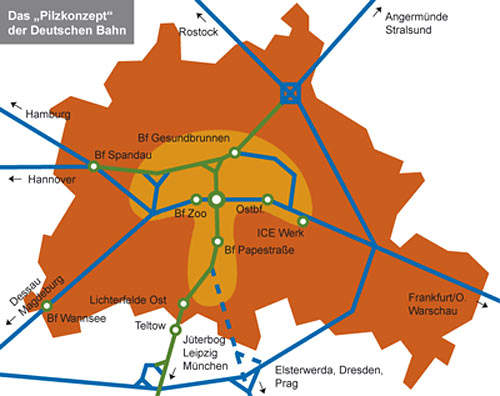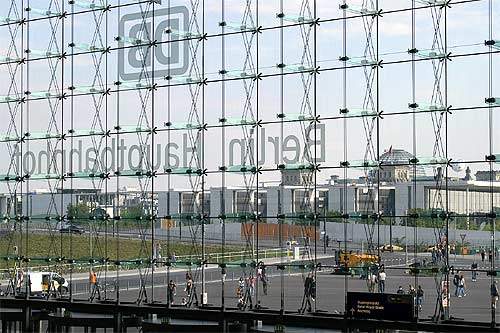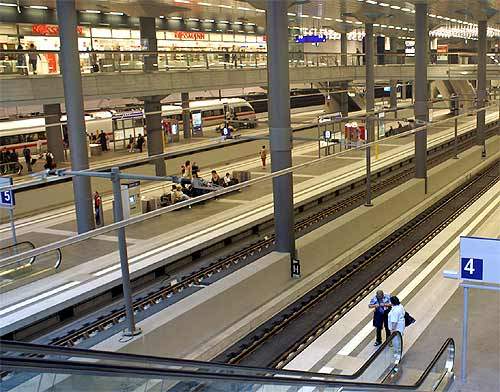At national reunification in October 1990, Berlin’s rail network and services had undergone years of fragmentation through war damage and political division. Therefore, the restored capital effectively had two transport systems.
Terminus stations had long been closed and in spite of the east-west elevated ‘Stadtbahn’ route connecting the two halves of the city, there were few through services. Long-distance services used several stations, mainly Zoologischer Garten (‘Zoo’) from West Germany, with Ostbahnhof (designated Berlin Hauptbahnhof, 1987–98) and Lichtenberg for East Germany and Eastern Bloc destinations.
Berlin’s public transport included buses, trams (in the former East only since 1967), U-Bahn and surface rail. Although often running adjacent to other rail services, as with the Stadtbahn, Berlin’s S-Bahn, which more widely in Germany is also termed ‘Stadt Bahn’, is a separate third-rail 800V DC system.
Although some U-Bahn and S-Bahn routes were restored post-1990, capacity limitations and divided operational aspects did not reconcile with aspirations for the new capital. With construction having started in 1995, Berlin Hauptbahnhof (Hbf) and the four-track north-south rail tunnel opened in May 2006, just in time for the football World Cup.
The Berlin Hauptbahnhof project remains central to the development of a unified transport infrastructure for the city, as well as for Berlin’s integration with the national rail network.
North-South Tunnel project details
As part of Berlin’s reinstatement as capital, the ‘Pilzkonzept’ (Mushroom) plan was adopted in 1992. The stalk is a new north-south tunnel, the cap being the existing northern rail ring, with the Stadtbahn as the cap’s base.
The north-south route crossed the Stadtbahn at Lehrter Bhf, chosen as the site of the future central station. Tunnel alignment north from Potsdamer Platz, past the Government quarter, was largely devoid of buildings, a by-product of a separated city and the removal of Berlin Wall installations. The project’s new stations and their related developments also serve a social role, filling a physical divide.
The original design assumed that the Hbf would accommodate the Hamburg-Berlin Transrapid Maglev, although that project’s troubled evolution meant an upgrade of the route to Ausbaustrecke (ABS) standards was implemented instead.
In spite of easy ground level access, tunnelling was made difficult by sandy ground with a high water table, plus the hazards and delays posed by unexploded munitions in this much fought over area.
Tunnelling under and building over the River Spree and harbour areas near the still-operating Stadtbahn brought further technical challenges, as did the environmentally sensitive Tiergarten and adjacent national symbols, the Reichstag and Brandenburg Gate.
Beset by ground water problems, the new 1.8km U55 route opened in August 2009. It links Berlin Hbf to the S and U-Bahns at Unter den Linden (Pariser Platz) near the Brandenburg Gate.
Berlin Hauptbahnhof infrastructure
Berlin Hauptbahnhof construction had to include continued operation and complete rebuilding of S-Bahn services with eventual demolition of Lehrter Bahnhof. The Spree was temporarily re-channelled to allow for sub-surface works that included provision for the Tiergarten road tunnel and U-Bahn.
The open chamber for the lower level and mezzanines was created by opening out a series of smaller concrete box structures. There are two levels for rail traffic, with six curving platforms (two for S-Bahn) at Stadtbahn level 10m above ground, and eight low level platforms, 15m below ground level.
To bring light in, extensive use was made of glass with wide spaces left around lifts and escalators. The cause of building delays, and suffering storm damage in January 2007, the curved east-west roof features a photovoltaic system that can provide 2% of the station’s electricity needs.
The four tunnel tubes that open at the platforms were created with tunnel boring machines, similarly south from Potsdammer Platz station. A mix of cut and cover and sunken pre-fabricated tubes were also used to complete the tunnel. To reduce maintenance, slab track is used throughout and traction current is collected overhead through a solid rail rather than wire.
Other new stations and upgrades of existing track and stations have contributed to extensive service modifications. Timings have in the main been accelerated, although Dresden services have been slowed by switching to a north-south routing through Berlin’s centre, a change that also has ended IC/EC services at Schönefeld Airport. Similarly, Zoo station has lost ICE/IC/EC services.
Rolling stock
Being a realignment rather than an introduction of services, new rolling stock has not figured as part of this project. Extra stock was drafted in to cope with traffic generated by the World Cup, a tactic that may be redeployed for other short-term demand.
Future Berlin Hauptbahnhof development
Initially an isolated single train shuttle service with its only intermediate station at the Reichstag, in the longer term U55 will join the U5 extension from the Alexanderplatz transport hub in the former East Berlin. Work commenced in 2010, and is expected to be completed in 2020.
Scheduled to open in 2020, Berlin Brandenburg International Airport (BBI) will receive direct rail links to the terminals.
North-south S-Bahn services were envisaged with a shell infrastructure as part of the tunnel project, although a lower cost option in starting such services may involve new mixed-system stock. On the commercial front, space at and around Berlin Hbf will continue to be developed. Lease expiry at Potsdamer Platz may see DB relocating there in the next decade.










